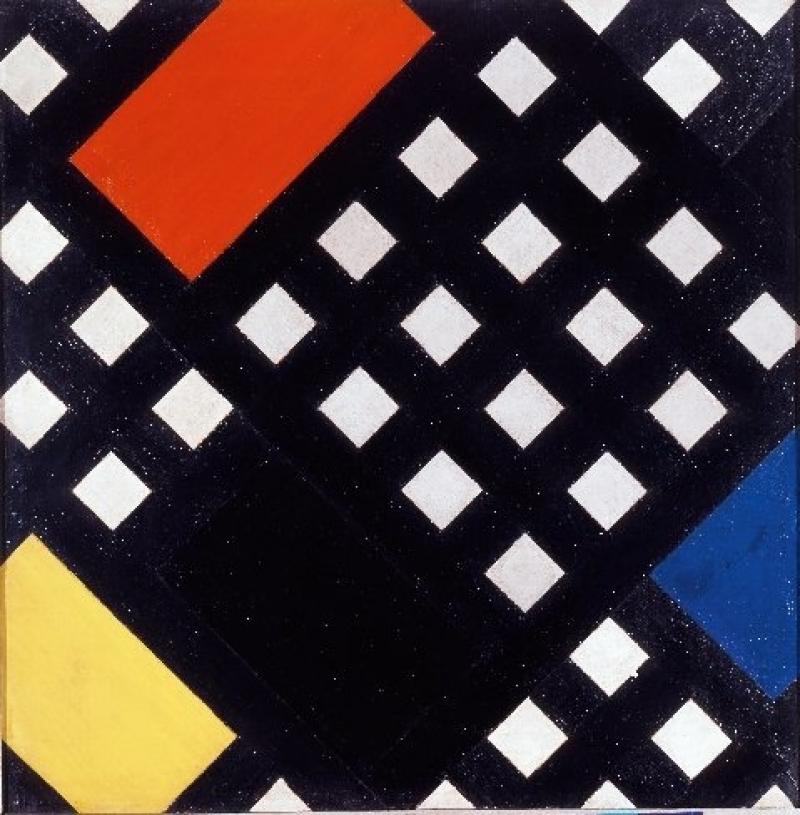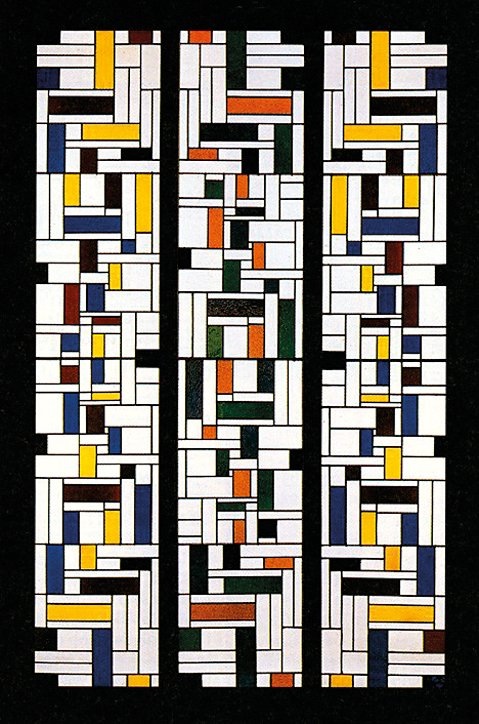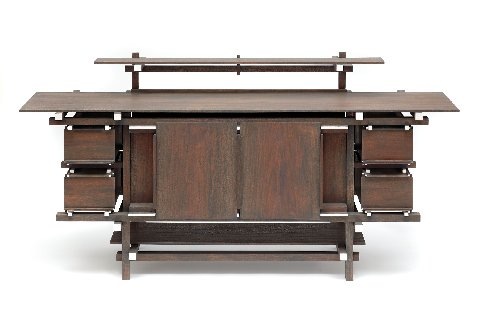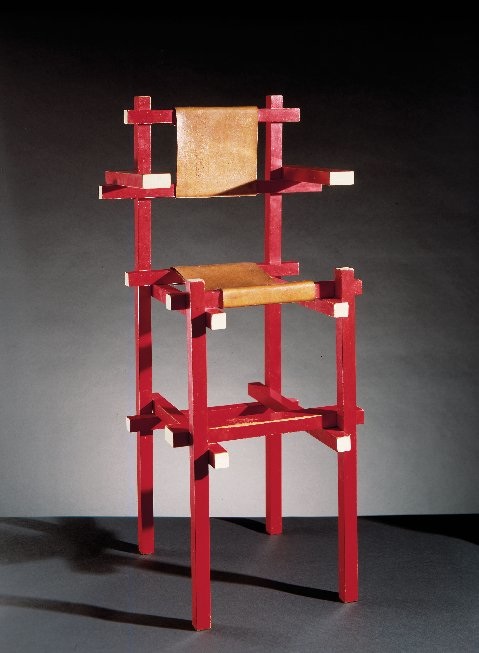Van Doesburg and the International Avant-Garde: Constructing a New World, Tate Modern | reviews, news & interviews
Van Doesburg and the International Avant-Garde: Constructing a New World, Tate Modern
Van Doesburg and the International Avant-Garde: Constructing a New World, Tate Modern
The future is square in Tate Modern's mammoth survey of Dutch movement

Modernist art movements are a lot like totalitarian regimes. They produce their declaratory manifestos, send forth their declamatory edicts, and, before you know it, a Year Zero mentality prevails: the past must be declared null and void.
Take, for instance, the great quarrel over the diagonal. In 1923, van Doesburg and Piet Mondrian fell out over it. Mondrian held firm that the future lay in horizontal and vertical lines, while van Doesburg insisted that, no, the diagonal must be permitted (actually, one feels that van Doesburg may have been a bit of an anarchist at heart, and straight lines and squares simply couldn’t contain him, since he also flirted with the Dadaists under the pseudonym I K Bonset.) Needless to say, this led to a complete severing of relations, the two only resuming contact six years later.
 Under the editorship of van Doesburg in 1917, De Stijl ("The Style") was founded initially as a journal, then as a fully fledged art movement. Painters, sculptors, designers and architects sought to unite their previously segregated art forms. So artists worked in practical design, designers in architectural practice, and painters in three dimensions. Designers including Gerrit Rietveld and architect J P Oud were soon inspired to join in. Moreover, it was a style that was to prove hugely influential to the Bauhaus, a movement that had previously adopted an English-inspired Arts and Crafts aesthetic. Still, you would never describe De Stijl as a homogenous movement: other artists whose aesthetic was quite removed from its strict geometry also featured, both in the journal and in the exhibitions van Doesburg organised.
Under the editorship of van Doesburg in 1917, De Stijl ("The Style") was founded initially as a journal, then as a fully fledged art movement. Painters, sculptors, designers and architects sought to unite their previously segregated art forms. So artists worked in practical design, designers in architectural practice, and painters in three dimensions. Designers including Gerrit Rietveld and architect J P Oud were soon inspired to join in. Moreover, it was a style that was to prove hugely influential to the Bauhaus, a movement that had previously adopted an English-inspired Arts and Crafts aesthetic. Still, you would never describe De Stijl as a homogenous movement: other artists whose aesthetic was quite removed from its strict geometry also featured, both in the journal and in the exhibitions van Doesburg organised.
Tate Modern’s mammoth survey of the movement is really quite a marvel, beautifully installed, intelligently curated and rich with historical detail. Its sweep is broad and rigorous, rather like the movement it celebrates. It encompasses not only the austere geometric paintings - the Compositions, Decompositions, Counter-Compositions and Simultaneous Counter-Compositions - of Doesburg, but his architectural designs, his new typography, his poetry and his stained glass windows (the latter are quite lovely, in fact - pictured above). These are shown alongside the canvases of Mondrian, and one begins to appreciate how much more varied van Doesburg’s activities were.
 Although you may occasionally feel disengaged by the repetitious imaginary - you are certain to leave with retinas imprinted with primary-coloured squares - there are plenty of pieces that will simply stop you in your tracks. Rietveld’s furniture designs, for example. If you ever imagine modernist design to be, well, a bit on the bland side, then take a look at Rietveld’s beautifully crafted Sideboard (pictured right). With its jutting and intersecting lines, there’s a lot going on in that sideboard; it’s kind of like a beautiful, rather complicated symphony, a symphony in sycamore brown, perhaps. (It’s not for nothing that abstract artists have often given their works the titles of musical forms.) But then again, I’m sure you'd find no use for Rietveld’s Child’s Highchair. (pictured below). Comfort and safety were not, it seems, necessary requirements of modernist design
Although you may occasionally feel disengaged by the repetitious imaginary - you are certain to leave with retinas imprinted with primary-coloured squares - there are plenty of pieces that will simply stop you in your tracks. Rietveld’s furniture designs, for example. If you ever imagine modernist design to be, well, a bit on the bland side, then take a look at Rietveld’s beautifully crafted Sideboard (pictured right). With its jutting and intersecting lines, there’s a lot going on in that sideboard; it’s kind of like a beautiful, rather complicated symphony, a symphony in sycamore brown, perhaps. (It’s not for nothing that abstract artists have often given their works the titles of musical forms.) But then again, I’m sure you'd find no use for Rietveld’s Child’s Highchair. (pictured below). Comfort and safety were not, it seems, necessary requirements of modernist design
 This labyrinthine exhibition reinstates van Doesburg to his rightful place. He was the driving force behind De Stijl, but unlike Mondrian he did not become a cult figure, nor even a remotely celebrated one. His name is largely forgotten. This is not because Mondrian was a better artist - I don't think he was, and excepting the direction of their lines, there is often little to distinguish their painterly styles. Rather, it is largely because Mondrian lived long enough to go off to New York just as that city was becoming the art centre of the universe. And, in turn, it was New York that inspired Mondrian’s wonderfully jazzy Boogie Woogie paintings. By then, van Doesburg had already been dead for nearly a decade, dying of a heart attack in his late 50s in 1931. And with him died the journal and movement he founded.
This labyrinthine exhibition reinstates van Doesburg to his rightful place. He was the driving force behind De Stijl, but unlike Mondrian he did not become a cult figure, nor even a remotely celebrated one. His name is largely forgotten. This is not because Mondrian was a better artist - I don't think he was, and excepting the direction of their lines, there is often little to distinguish their painterly styles. Rather, it is largely because Mondrian lived long enough to go off to New York just as that city was becoming the art centre of the universe. And, in turn, it was New York that inspired Mondrian’s wonderfully jazzy Boogie Woogie paintings. By then, van Doesburg had already been dead for nearly a decade, dying of a heart attack in his late 50s in 1931. And with him died the journal and movement he founded.
- Van Doesburg and the International Avant-Garde: Constructing a New World is at Tate Modern until 16 May
Share this article
The future of Arts Journalism
You can stop theartsdesk.com closing!
We urgently need financing to survive. Our fundraising drive has thus far raised £49,000 but we need to reach £100,000 or we will be forced to close. Please contribute here: https://gofund.me/c3f6033d
And if you can forward this information to anyone who might assist, we’d be grateful.

Subscribe to theartsdesk.com
Thank you for continuing to read our work on theartsdesk.com. For unlimited access to every article in its entirety, including our archive of more than 15,000 pieces, we're asking for £5 per month or £40 per year. We feel it's a very good deal, and hope you do too.
To take a subscription now simply click here.
And if you're looking for that extra gift for a friend or family member, why not treat them to a theartsdesk.com gift subscription?
more Visual arts
 'We are bowled over!' Thank you for your messages of love and support
Much-appreciated words of commendation from readers and the cultural community
'We are bowled over!' Thank you for your messages of love and support
Much-appreciated words of commendation from readers and the cultural community
![SEX MONEY RACE RELIGION [2016] by Gilbert and George. Installation shot of Gilbert & George 21ST CENTURY PICTURES Hayward Gallery](https://theartsdesk.com/sites/default/files/styles/thumbnail/public/mastimages/Gilbert%20%26%20George_%2021ST%20CENTURY%20PICTURES.%20SEX%20MONEY%20RACE%20RELIGION%20%5B2016%5D.%20Photo_%20Mark%20Blower.%20Courtesy%20of%20the%20Gilbert%20%26%20George%20and%20the%20Hayward%20Gallery._0.jpg?itok=7tVsLyR-) Gilbert & George, 21st Century Pictures, Hayward Gallery review - brash, bright and not so beautiful
The couple's coloured photomontages shout louder than ever, causing sensory overload
Gilbert & George, 21st Century Pictures, Hayward Gallery review - brash, bright and not so beautiful
The couple's coloured photomontages shout louder than ever, causing sensory overload
 Lee Miller, Tate Britain review - an extraordinary career that remains an enigma
Fashion photographer, artist or war reporter; will the real Lee Miller please step forward?
Lee Miller, Tate Britain review - an extraordinary career that remains an enigma
Fashion photographer, artist or war reporter; will the real Lee Miller please step forward?
 Kerry James Marshall: The Histories, Royal Academy review - a triumphant celebration of blackness
Room after room of glorious paintings
Kerry James Marshall: The Histories, Royal Academy review - a triumphant celebration of blackness
Room after room of glorious paintings
 Folkestone Triennial 2025 - landscape, seascape, art lovers' escape
Locally rooted festival brings home many but not all global concerns
Folkestone Triennial 2025 - landscape, seascape, art lovers' escape
Locally rooted festival brings home many but not all global concerns
 Sir Brian Clarke (1953-2025) - a personal tribute
Remembering an artist with a gift for the transcendent
Sir Brian Clarke (1953-2025) - a personal tribute
Remembering an artist with a gift for the transcendent
 Emily Kam Kngwarray, Tate Modern review - glimpses of another world
Pictures that are an affirmation of belonging
Emily Kam Kngwarray, Tate Modern review - glimpses of another world
Pictures that are an affirmation of belonging
 Kiefer / Van Gogh, Royal Academy review - a pairing of opposites
Small scale intensity meets large scale melodrama
Kiefer / Van Gogh, Royal Academy review - a pairing of opposites
Small scale intensity meets large scale melodrama
 Jenny Saville: The Anatomy of Painting, National Portrait Gallery review - a protégé losing her way
A brilliant painter in search of a worthwhile subject
Jenny Saville: The Anatomy of Painting, National Portrait Gallery review - a protégé losing her way
A brilliant painter in search of a worthwhile subject
 Abstract Erotic, Courtauld Gallery review - sculpture that is sensuous, funny and subversive
Testing the boundaries of good taste, and winning
Abstract Erotic, Courtauld Gallery review - sculpture that is sensuous, funny and subversive
Testing the boundaries of good taste, and winning
 Edward Burra, Tate Britain review - watercolour made mainstream
Social satire with a nasty bite
Edward Burra, Tate Britain review - watercolour made mainstream
Social satire with a nasty bite
 Ithell Colquhoun, Tate Britain review - revelations of a weird and wonderful world
Emanations from the unconscious
Ithell Colquhoun, Tate Britain review - revelations of a weird and wonderful world
Emanations from the unconscious

Add comment